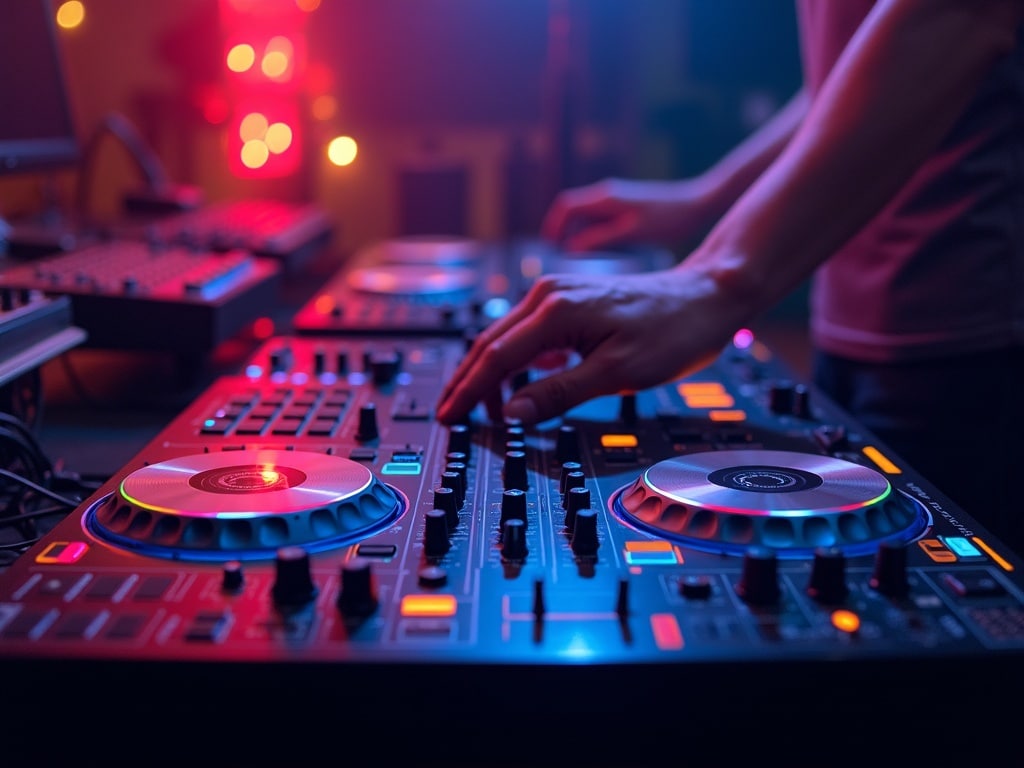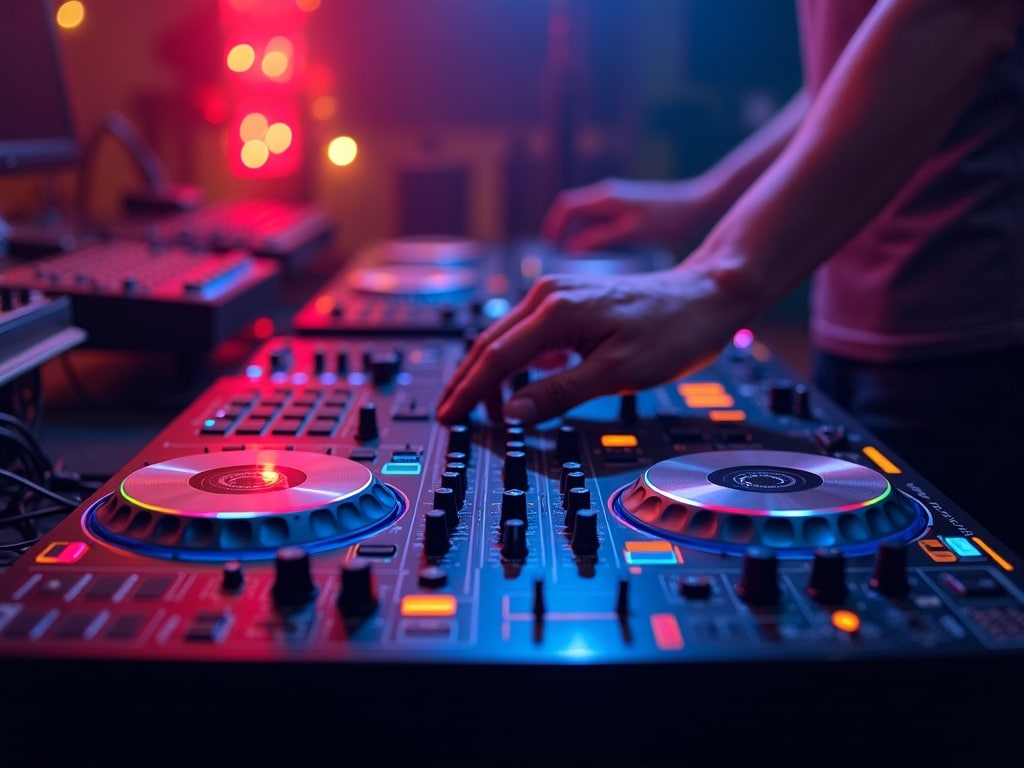DJ Controller Setup Secrets: Unlock Your Inner DJ (Even If You're Tone Deaf)
Ever dreamt of commanding the dance floor, seamlessly blending tracks and whipping the crowd into a frenzy? Maybe you’ve watched a DJ in action, mesmerized by their ability to weave sonic tapestries. The good news? You don’t need decades of experience or a natural gift for music to start your DJ journey. The secret weapon is a DJ controller, and this guide will demystify the entire setup process, even if your musical experience peaks at humming in the shower.
We’ll break down every step, from understanding what a DJ controller *actuallyis to troubleshooting those inevitable tech glitches. Get ready to turn your bedroom into a pulsating club – no prior musical talent required!
Understanding DJ Controllers: What They Are and Why You Need One
Forget visions of dusty turntables and crates of vinyl. A DJ controller is a streamlined, all-in-one solution for modern mixing. Think of it as the cockpit of your DJ adventure. It emulates the traditional DJ setup but leverages the power of digital music and software.
- What it is: A hardware device that gives you tactile control over DJ software running on your computer. It typically includes platters (for scratching and manipulating tracks), faders (for controlling volume), knobs (for adjusting EQ and effects), and buttons (for cueing, looping, and triggering samples).
- Why you need one:
- Portability: Far more compact and lightweight than traditional setups.
- Cost-effective: Cheaper than buying separate turntables, mixers, and CDJs.
- Versatility: Allows you to play a vast library of digital music.
- Ease of Use: Modern controllers and software are designed to be user-friendly, even for beginners.
- Simply put: It's the bridge between your musical ideas and the speakers.
The controller doesn't actually produce sound itself; it sends commands to the DJ software, which then outputs the audio. This makes it crucial to understand the relationship between the hardware and the software.
Essential Equipment for Your DJ Controller Setup: Beyond the Controller Itself
While the DJ controller is the star of the show, it needs a supporting cast to truly shine. Here's a checklist of the essential gear you'll need to get started:
- Laptop or Computer: This is the brains of the operation, running the DJ software and storing your music library. Ensure it meets the minimum system requirements of your chosen software.
- DJ Software: Popular options include Serato DJ, Traktor Pro, Rekordbox DJ, and Virtual DJ. Many controllers come bundled with a lite version of the software.
- Speakers: You need a way to hear (and for others to hear) your mixes! Options range from powered studio monitors for home practice to PA systems for larger events.
- Headphones: Crucial for cueing up tracks and monitoring your mix before it goes out to the audience. Closed-back headphones are recommended to block out external noise.
- Cables: You'll need USB cables to connect your controller to your computer, and audio cables (RCA, XLR, or 1/4 inch) to connect your controller to your speakers.
Optional but Recommended:
- Headphone Stand: Keeps your headphones safe and accessible.
- Laptop Stand: Elevates your laptop for better ergonomics.
- External Hard Drive: To store your music library, especially if you have a large collection.
- Microphone: For announcements or MCing (more on that later).
Connecting Your DJ Controller: Cables, Connections, and Compatibility
This is where things can seem a bit daunting, but don't worry, it's simpler than it looks. The key is to understand the different types of connections and how they relate to each other.
- USB Connection: This is the most important connection, as it transmits data between your controller and your computer. Most controllers use a standard USB-B to USB-A cable.
- Audio Outputs: These connect your controller to your speakers. The most common types are:
- RCA: Typically found on smaller controllers and home audio systems.
- XLR: A balanced connection that provides better sound quality and is less susceptible to noise. Common on professional audio equipment.
- 1/4 inch (TRS): Another balanced connection option, often found on studio monitors.
- Headphone Output: Usually a 1/4 inch or 3.5mm (1/8 inch) jack.
Connection Steps:
- Connect the USB cable from your controller to your computer.
- Connect the audio outputs from your controller to the inputs on your speakers (using the appropriate cables).
- Connect your headphones to the headphone output on your controller.
- Plug in your speakers and turn them on.
Compatibility Considerations:
- Driver Installation: Some controllers require you to install drivers on your computer for them to function properly. Check the manufacturer's website for the latest drivers.
- Software Compatibility: Ensure your controller is compatible with your chosen DJ software. Most controllers are class-compliant, meaning they'll work without drivers on most operating systems, but compatibility can vary.
DJ Software Setup: Installation, Configuration, and Basic Use
With your controller physically connected, it's time to bring the software to life. This is where you'll load your music, mix tracks, and control the sound.
- Installation: Download and install your chosen DJ software from the official website. Follow the on-screen instructions.
- Activation/Registration: You'll likely need to activate the software with a serial number or license key (usually provided when you purchase the software or the controller bundle).
- Audio Settings: Configure the audio settings in the software to use your DJ controller as the audio interface. This usually involves selecting your controller from a dropdown menu of available devices.
- MIDI Mapping (If Necessary): Most modern controllers are plug-and-play, meaning they're automatically mapped to the software. However, if you're using an older controller or want to customize the controls, you may need to manually map the MIDI functions.
- Importing Your Music Library: Import your music files into the software's library. Most software supports a variety of audio formats, including MP3, WAV, and AIFF.
Basic Software Use:
- Loading Tracks: Drag and drop tracks from your library onto the virtual decks in the software.
- Playback Controls: Use the play/pause buttons, cue buttons, and pitch faders on your controller to control the playback of the tracks.
- Mixing: Use the volume faders and EQ knobs to blend the tracks together seamlessly.
- Cueing: Use your headphones to listen to the next track and find the perfect cue point before bringing it into the mix.
Speaker Setup and Sound Considerations: Getting the Best Audio Quality
Having great gear is only half the battle; proper speaker placement and sound considerations are crucial for achieving optimal audio quality.
- Speaker Placement: Position your speakers so they form an equilateral triangle with your listening position (your head). This ensures a balanced stereo image.
- Speaker Height: Ideally, the tweeters (the small speakers that produce high frequencies) should be at ear level.
- Room Acoustics: Hard surfaces like walls and floors can reflect sound, causing unwanted echoes and resonances. Consider using acoustic treatment (e.g., foam panels, bass traps) to improve the sound in your room.
- Volume Levels: Avoid setting your volume levels too high, as this can damage your speakers and your hearing. Start with a low volume and gradually increase it until you reach a comfortable level.
Types of Speakers:
- Powered Studio Monitors: Designed for accurate sound reproduction, making them ideal for mixing and critical listening. They have built-in amplifiers.
- PA Speakers: Designed for live performance and larger venues. They typically require an external amplifier.
- Home Stereo Speakers: Can be used for practice, but may not be as accurate as studio monitors.

Headphone Setup: Monitoring and Cueing Like a Pro
Headphones are your secret weapon as a DJ. They allow you to preview and prepare the next track without the audience hearing it, ensuring smooth transitions and flawless mixes.
- Headphone Choice: Opt for closed-back headphones that provide good isolation, blocking out external noise and allowing you to focus on the music.
- Headphone Connection: Connect your headphones to the headphone output on your DJ controller.
- Cueing Technique: Use the cue buttons on your controller to send the next track to your headphones. Adjust the volume and EQ to match the current track.
- Beatmatching: Use your headphones to listen to both tracks simultaneously and adjust the pitch (speed) of the incoming track until it's perfectly synchronized with the current track. This is a fundamental DJ skill.
Monitoring Tips:
- Practice Regularly: The more you practice cueing and beatmatching with headphones, the better you'll become.
- Avoid Listening Fatigue: Take breaks to rest your ears, especially during long practice sessions.
- Proper Volume: Keep the headphone volume at a reasonable level to prevent hearing damage.
Microphone Setup (Optional): Adding Vocals or MCing to Your Set
Adding a microphone to your setup allows you to engage with the audience, make announcements, or even add vocals to your mixes. This is purely optional, but adds another level of entertainment to your set.
- Microphone Type: A dynamic microphone is a good choice for live performance, as it's durable and less susceptible to feedback.
- Microphone Connection: Connect your microphone to a microphone input on your DJ controller or to a separate audio interface. Many controllers do not have mic inputs.
- Gain Adjustment: Adjust the gain (input level) on the microphone channel to ensure a strong signal without clipping (distortion).
- EQ and Effects: Use the EQ knobs on your controller or in your DJ software to shape the sound of your voice. You can also add effects like reverb or delay.
MCing Tips:
- Speak Clearly: Enunciate your words and speak at a moderate pace.
- Engage with the Audience: Make eye contact, smile, and use humor to connect with the crowd.
- Be Mindful of Your Language: Avoid using offensive or inappropriate language.
Power Management and Cable Organization: Keeping Your Setup Tidy and Safe
A messy setup is not only unsightly but can also be a safety hazard. Proper power management and cable organization are essential for a professional and reliable DJ setup.
- Power Conditioner: Protect your equipment from power surges and voltage fluctuations.
- Cable Management: Use cable ties, zip ties, or Velcro straps to bundle and organize your cables.
- Labeling: Label your cables to easily identify them.
- Avoid Overcrowding: Don't overload power outlets or extension cords.
- Trip Hazards: Secure cables to the floor or use cable covers to prevent tripping.
Benefits of a Tidy Setup:
- Improved Reliability: Reduces the risk of accidental disconnections.
- Professional Appearance: A clean setup looks more professional and organized.
- Safety: Reduces the risk of electrical hazards and tripping.
Troubleshooting Common DJ Controller Setup Issues: Solutions to Frequent Problems
Even with the best equipment and preparation, things can sometimes go wrong. Here are some common DJ controller setup issues and how to fix them:
- No Sound:
- Check all your cable connections.
- Make sure your speakers are turned on and the volume is turned up.
- Verify that your DJ software is properly configured to use your controller as the audio interface.
- Check the master volume and channel volume levels in your software.
- Controller Not Recognized:
- Make sure your controller is properly connected to your computer via USB.
- Install the latest drivers for your controller.
- Try a different USB port.
- Restart your computer and DJ software.
- Latency (Delay):
- Increase the buffer size in your DJ software's audio settings.
- Close any unnecessary programs running on your computer.
- Use a faster computer with more RAM.
- Distortion:
- Lower the gain (input level) on your DJ controller and in your software.
- Avoid clipping (overloading) your audio signal.
- Check your speaker connections and make sure they're not loose.
If you're still having trouble, consult the user manual for your DJ controller or contact the manufacturer's support team.
Advanced DJ Controller Techniques: Expanding Your Skills and Creativity
Once you've mastered the basics, it's time to explore more advanced techniques to elevate your DJing skills:
- Advanced Mixing Techniques:
- Harmonic Mixing: Mixing tracks that are in compatible keys to create a more pleasing and seamless sound.
- Beat Gridding: Accurately marking the beats in your tracks to ensure perfect synchronization.
- Using Effects Creatively: Experiment with different effects like reverb, delay, flanger, and phaser to add texture and interest to your mixes.
- Sampling and Remixing:
- Using your DJ software to trigger samples and loops in your sets.
- Creating on-the-fly remixes by layering different tracks and samples.
- Scratching:
- Learning basic scratching techniques like baby scratches, forward scratches, and chirps.
- Practicing your timing and coordination to create smooth and rhythmic scratches.
- Performance and Stage Presence:
- Engaging with the audience and creating a connection with them.
- Using gestures and movements to enhance your performance.
- Developing your own unique style and personality as a DJ.
So, there you have it – a comprehensive guide to setting up your DJ controller and unlocking your inner DJ. Remember, practice makes perfect. Don't be afraid to experiment, make mistakes, and learn from them. The most important thing is to have fun and express your creativity. Now go out there and rock the dance floor – tone-deafness be damned!

